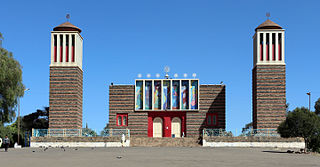
The Ethiopian Orthodox Tewahedo Church is the largest of the Oriental Orthodox Churches. One of the few Christian churches in sub-Saharan Africa originating before European colonization of the continent, the Ethiopian Orthodox Tewahedo Church dates back to the acceptance of Christianity by the Kingdom of Aksum in 330, and has between 36 million and 51 million adherents in Ethiopia. It is a founding member of the World Council of Churches. The Ethiopian Orthodox Tewahedo Church is in communion with the other Oriental Orthodox churches.

Axum, also spelled Aksum, is a town in the Tigray Region of Ethiopia with a population of 66,900 residents. It is the site of the historic capital of the Aksumite Empire.

Frumentius was a Phoenician Christian missionary and the first bishop of Axum who brought Christianity to the Kingdom of Aksum. He is sometimes known by other names, such as Abuna and Aba Salama.

The Church of Our Lady, Mary of Zion is an Ethiopian Orthodox Tewahedo Church which is claimed to contain the Ark of the Covenant.

Abune Paulos was the fifth Patriarch of the Ethiopian Orthodox Tewahedo Church from 1992 to his death in 2012. His full title was "His Holiness Abuna Paulos, Fifth Patriarch of the Orthodox Tewahido Church of Ethiopia, Ichege of the see of Saint Tekle Haymanot, Archbishop of Axum and one of the seven serving Presidents of the World Council of Churches."

Abune Theophilos, also known as Abune Tewophilos, was the second Patriarch of the Ethiopian Orthodox Tewahedo Church. He officially succeeded Abuna Basilios in 1971 after he had assumed the role of acting patriarch upon Abuna Basilios's death in 1970.

Abuna Takla Haymanot was the third Patriarch of the Ethiopian Orthodox Tewahedo Church from 1976 to 1988.

Religion in Ethiopia consists of a number of faiths. Among these mainly Abrahamic religions, the most numerous is Christianity totaling at 67.3%, followed by Islam at 31.3%. There is also a longstanding but small Ethiopian Jewish community. Some adherents of the Baháʼí Faith likewise exist in a number of urban and rural areas. Additionally, there is also a substantial population of the adherents of traditional faiths.

Abuna Aregawi was a sixth-century Syrian monk and canonized by the Ethiopian Orthodox Tewahedo Church, as well as by the Ethiopian Catholic Church, as well as the Eritrean Orthodox Church. He is one of the Nine Saints, who came from the Roman Empire to Ethiopia, and are credited for founding many monasteries and churches and was the main force behind installing monasticism in Ethiopia.

Eritrea as a country and the Eritrean community are multi-religious. Eritrea has two dominant religions, Christianity and Islam.

Religion in Eritrea consists of a number of faiths. The two major religions in Eritrea are Christianity and Islam. However, the number of adherents of each faith is subject to debate. Estimates of the Christian share of the population range from 47% and 63%, while estimates of the Muslim share of the population range from 37% to 52%.

Ethiopia is one of the oldest countries in Africa; the emergence of Ethiopian civilization dates back thousands of years. Abyssinia or rather "Ze Etiyopia" was ruled by the Semitic Abyssinians (Habesha) composed mainly of the Amhara, Tigrayans and the Cushitic Agaw. In the Eastern escarpment of the Ethiopian highlands and more so the lowlands were the home of the Harari/Harla that founded Sultanates such as Ifat and Adal and the Afars. In the central and south were found the ancient Sidama and Semitic Gurage, among others.

The Eritrean Orthodox Tewahedo Church is one of the Oriental Orthodox Churches with its headquarters in Asmara, Eritrea. Its autocephaly was recognised by Pope Shenouda III of Alexandria, Pope of the Coptic Orthodox Church, after Eritrea gained its independence from Ethiopia in 1993. Thus, the Eritrean Church accords a primacy of honor to the Coptic Church.

Abune Mathias is the sixth and current Patriarch of the Ethiopian Orthodox Tewahedo Church since 2013. His full title is "His Holiness Abune Mathias I, Sixth Patriarch and Catholicos of Ethiopia, Archbishop of Axum and Ichege of the See of Saint Taklehaimanot".
Events of 2020 in Ethiopia.
Events in the year 2021 in Ethiopia.

The Axum massacre was a massacre of about 100–800 civilians that took place in Axum during the Tigray War. The main part of the massacre occurred on the afternoon and evening of 28 November 2020, continuing on 29 November, with smaller numbers of extrajudicial killings taking place earlier, starting from 19 November and during the weeks following the 28–29 November weekend. The massacre was attributed to the Eritrean Defence Forces (EDF) by Amnesty International, Associated Press, the Ethiopian Human Rights Commission (EHRC), Human Rights Watch (HRW) and Adigrat University lecturer Getu Mak.
The following is chronology of the Orthodox Tewahedo Ethiopian and Eritrean Orthodox Churches from its base history to present.

On 22 January 2023, three bishops led by Abune Sawiros formed 25-episcopate in Oromia and Southern Nations, Nationalities, and Peoples' Region that is condemned by the Holy Synod of the Ethiopian Orthodox Church, led by Patriarch Abune Mathias. The group accused the Holy Synod of discriminating ethnic groups. On 26 January, the Holy Synod excommunicated them, while one archbishop of the group demanded apology to the Ethiopian Orthodox Church officials.

The Tigrayan Orthodox Tewahedo Church is one of the Oriental Orthodox Churches with its headquarters in Axum, Tigray Region. It declared autocephaly on 7 May 2021, accusing the Ethiopian Orthodox Tewahedo Church of not doing enough to speak out against the Tigray war, and for being too closely aligned with the Ethiopian government.
















